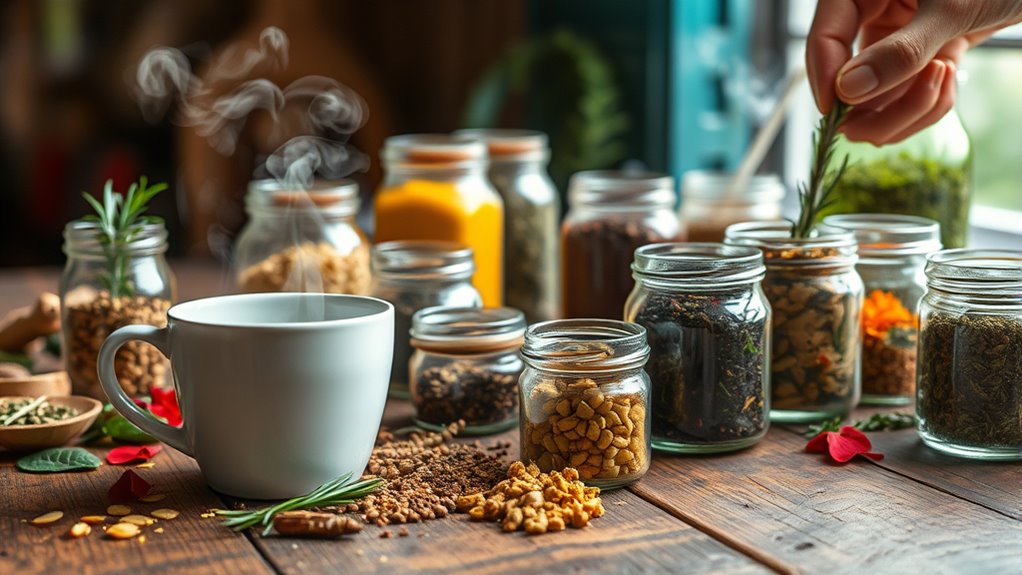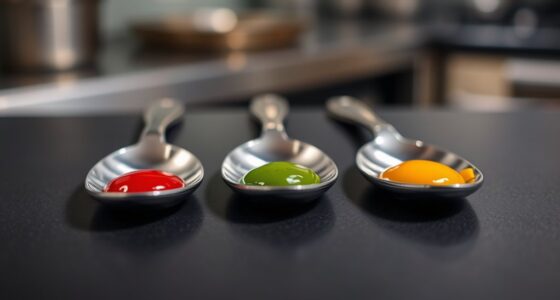Aroma training helps you develop a richer sensory vocabulary and sharper olfactory skills by focusing on scent recognition and description. You’ll learn to identify subtle fragrances, associate aromas with flavors, and expand your vocabulary through consistent practice like journaling and exposure to diverse scents. By experimenting with aroma pairings and mindful tasting, you deepen your sensory awareness. Keep exploring these techniques, and you’ll discover how to articulate aromas more precisely and confidently.
Key Takeaways
- Practice regularly with diverse scents to enhance recognition and descriptive accuracy.
- Keep a scent journal to document and refine your sensory vocabulary over time.
- Engage in aroma pairing exercises to understand how different scents interact and complement each other.
- Focus on articulating specific qualities like intensity, earthiness, or sweetness to deepen descriptive skills.
- Use tasting techniques to connect aromas with flavors, strengthening overall olfactory perception.

Have you ever wondered how to sharpen your sense of smell? Developing a nuanced olfactory perception isn’t just about recognizing scents; it’s about training your brain to distinguish and articulate them. Aroma training involves building a sensory vocabulary that enhances your ability to identify and describe aromas accurately. One effective way to do this is by practicing tasting techniques that focus on scent recognition before even taking a sip or bite. When you engage in tasting techniques, you learn to detect subtle differences in aroma, which deepens your understanding of flavor profiles. For example, when tasting wine or coffee, you don’t just focus on the taste itself but pay close attention to the aroma that precedes it. This habit trains your nose to pick up on nuances you might overlook initially, sharpening your overall sense of smell. Additionally, sensory development can be accelerated by regularly exposing yourself to a variety of fragrances in different contexts. Aroma pairing plays a crucial role in aroma training because it teaches you how different scents interact and complement each other. By experimenting with aroma pairing, you start to see how certain aromas can enhance or balance each other, which is essential for building your vocabulary. For instance, pairing a citrus scent with herbal notes can help you recognize the distinct qualities of each, while also understanding how they work together. As you explore these combinations, your ability to identify complex aromas improves, and your descriptive language becomes richer and more precise. Aroma pairing also encourages you to pay attention to the context in which scents are experienced, helping you to remember and articulate them more effectively. To truly build your sensory vocabulary, it’s important to keep a scent journal. Record your observations and describe each aroma in detail, focusing on qualities like intensity, freshness, earthiness, or sweetness. This practice reinforces your recognition skills and helps you internalize new vocabulary. Over time, you’ll notice patterns and develop a more refined palate, enabling you to articulate what you’re experiencing with greater confidence. Regular exposure to different aromas and deliberate practice of tasting techniques and aroma pairing are key to expanding your olfactory awareness. Whether you’re a wine enthusiast, chef, or simply a curious learner, sharpening your sense of smell is a rewarding process that enhances your appreciation for flavors and scents. Building this sensory vocabulary allows you to savor experiences more fully and communicate them more vividly to others.
Frequently Asked Questions
How Often Should I Practice Aroma Training Sessions?
You should practice aroma training sessions 2 to 3 times a week for effective frequency planning. Keep each session around 15 to 20 minutes to maintain focus without fatigue. Consistency is key, so set a regular schedule that fits your routine. This frequency allows your senses to adapt and develop a richer vocabulary over time, helping you become more confident in identifying and describing different aromas.
Can Aroma Training Improve My Overall Smell Sensitivity?
Absolutely, aroma training can supercharge your smell sensitivity! Imagine noticing every scent around you—like a detective uncovering hidden clues. Regular practice helps combat olfactory adaptation, making your nose less dull and more alert. You’ll improve scent recognition, detecting nuances you never knew existed. Over time, your sense of smell will sharpen dramatically, turning everyday smells into a vivid, colorful world, and revealing a whole new level of sensory awareness.
What Are Some Common Mistakes Beginners Make?
You might overlook scent familiarity or rush into blind testing too soon, which can hinder your progress. Beginners often assume they’ll recognize aromas instantly, but developing your sense of smell takes time and patience. Instead, focus on slowly exploring different scents, noting subtle differences, and gradually increasing complexity. Avoid jumping into blind testing without a solid foundation, as it can lead to frustration and confusion. Consistent practice and mindful observation boost your scent recognition skills effectively.
How Long Does It Typically Take to See Progress?
Ever wonder how long it takes to notice progress in scent differentiation? Usually, you’ll start seeing results within a few weeks, but it varies based on your commitment. You’ll strengthen your olfactory memory as you practice regularly, making it easier to distinguish scents over time. Consistency is key—so keep practicing daily, and soon you’ll find yourself recognizing subtler aromas faster and more accurately.
Are There Specific Aromas I Should Focus on First?
Start with common essential oils like lavender, lemon, peppermint, and eucalyptus to improve your scent identification. Focusing on these familiar aromas helps you develop your sensory vocabulary quickly because you can easily recognize and differentiate them. As you become confident, gradually explore more complex scents. Consistent practice with these basics builds a strong foundation, making it easier to identify and appreciate a wider range of aromas over time.
Conclusion
By honing your aroma vocabulary through dedicated training, you’ll open a richer sensory experience. Imagine tasting a wine and instantly identifying its subtle hints of vanilla or citrus, elevating your appreciation and confidence. For example, Sarah, a novice taster, now confidently describes complex aromas after just a few sessions, enhancing her enjoyment and expertise. Keep practicing, stay curious, and soon you’ll find yourself savoring scents with a new level of understanding and delight.









